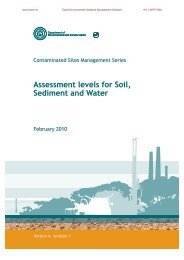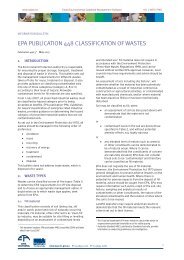Landfill Directive - ESdat
Landfill Directive - ESdat
Landfill Directive - ESdat
You also want an ePaper? Increase the reach of your titles
YUMPU automatically turns print PDFs into web optimized ePapers that Google loves.
www.esdat.net Esdat Environmental Database Management Software +61 2 8875 7948<br />
A8<br />
Appendix 8:<br />
Selected water quality standards<br />
The following selected water-quality standards are<br />
to be used in assessing the presence of pollution in<br />
controlled waters. It is important to note that the<br />
tables are for general guidance only and care should<br />
be exercised when applying these for specific<br />
purposes. This information is necessarily summarised.<br />
It may be necessary to refer back to the original<br />
source of the data for qualifying/clarifying<br />
information.<br />
Water-quality standards should be used only<br />
where they are relevant to the site being assessed.<br />
Key to standards referenced<br />
1 Figures for Environmental Quality Standards<br />
(EQS) are Annual Average Concentrations with<br />
Maximum Allowable Concentrations in brackets.<br />
Where a range of EQS for freshwater is given, it<br />
depends on the hardness of the water. Seek<br />
further advice from the Agency.<br />
2 World Health Organisation (WHO) Guidelines for<br />
Drinking Water Quality, 1984.<br />
The health value is a guideline value<br />
representing the concentration of a constituent<br />
that does not result in any significant risk to the<br />
consumer over a lifetime of exposure.<br />
The ATO is the concentration of the substance,<br />
at or below the health-based guideline value,<br />
which may affect the appearance, taste or odour<br />
of the water. The concentrations given are those<br />
likely to give rise to consumer complaints.<br />
3 Council <strong>Directive</strong> 98/83/EC on the quality of<br />
water intended for human consumption.<br />
4 UK Drinking Water Standards taken from:<br />
• Water Supply (Water Quality) Regulations 1989<br />
(SI 1989/1147) (as amended);<br />
• Water Supply (Water Quality) Regulations 2000<br />
(SI 2000/3184) (as amended).<br />
Environment Agency Hydrogeological Risk Assessment for <strong>Landfill</strong>s 75
www.esdat.net Esdat Environmental Database Management Software +61 2 8875 7948<br />
Contaminant units EQS EQS WHO WHO EU UK<br />
freshwater saltwater Health ATO Drinking Drinking<br />
(1) (1) (2) (2) Water Water<br />
Standards Standards<br />
(3) (4)<br />
Acrylamide ug/l 0.5 0.1 0.1<br />
Alachlor ug/l 20 0.1 0.1<br />
Aldicarb ug/l 10 0.1 0.1<br />
Aldrin ug/l 0.01 0.01 0.03 0.03 0.03<br />
Aluminium ug/l 200 200 200<br />
Ammonia (NH 3<br />
as N) mg/l 0.015 0.021 1.5<br />
Ammonium (as NH 4<br />
+) mg/l 0.5 0.5<br />
Antimony ug/l 5 5 5<br />
Arsenic ug/l 50 25 10 10 10<br />
Atrazine ug/l 2 2 2 0.1 0.1<br />
Azinphos-methyl ng/l 10 (40) 10 (40) 100 100<br />
Barium mg/l 0.7 1<br />
Bentazone mg/l 0.5 0.5 0.03 0.1 0.1<br />
Benzene ug/l 30 (300) 30 (300) 10 1 1<br />
Benzo [a] pyrene ug/l 0.7 0.01 0.01<br />
Biphenyl ug/l 25 25<br />
Boron mg/l 2 7 0.3 1 1<br />
Bromate ug/l 10 10<br />
Bromoxynil ug/l 100 (1000) 100 (1000) 0.1 0.1<br />
Cadmium ug/l 5 2.5 3 5 5<br />
Calcium mg/l 250<br />
Carbofuran ug/l 5 0.1 0.1<br />
Chlordane (all isomers) ug/l 0.2 0.1 0.1<br />
Chlorfenvinphos ug/l 0.01 (0.1) 0.01 (0.1) 0.1 0.1<br />
Chloride mg/l 250 250 250 250<br />
Chlorine ug/l 2 10<br />
Chloroform ug/l 12 12 200<br />
Chloroform extractable ug/l 1000<br />
substances<br />
Chlorphenylid ug/l 0.05 0.05 0.1 0.1<br />
Chloronitrotoluenes ug/l 10 10<br />
Chlorothalonil ug/l 0.1 0.1 0.1 0.1<br />
Chlorpropham ug/l 10 10 0.1 0.1<br />
Chlorotoluron ug/l 2 2 30 0.1 0.1<br />
Chromium ug/l 5 - 250 15 50 50 50<br />
Copper ug/l 1 - 28 5 2000 1000 2000 2000<br />
Coumaphos ug/l 0.01 (0.1) 0.04 (0.4) 0.1 0.1<br />
Cyanide ug/l 70 50 50<br />
Cyfluthrin ug/l 0.001 0.001 0.1 0.1<br />
76<br />
Environment Agency Hydrogeological Risk Assessment for <strong>Landfill</strong>s
www.esdat.net Esdat Environmental Database Management Software +61 2 8875 7948<br />
Contaminant units EQS EQS WHO WHO EU UK<br />
freshwater saltwater Health ATO Drinking Drinking<br />
(1) (1) (2) (2) Water Water<br />
Standards Standards<br />
(3) (4)<br />
2,4-dichlorophenoxyacetic acid ug/l 1 1 30 0.1 0.1<br />
(2,4-D), (ester form)<br />
Demetons ug/l 0.5 0.5 0.1 0.1<br />
Diazinon ug/l 0.01 (0.1) 0.015 (0.15) 0.1 0.1<br />
Dichlorodiphenyltrichloroethane ug/l 0.025 0.025<br />
(all isomers)<br />
Para, para-DDT ug/l 0.01 0.01 2 0.1 0.1<br />
1,2-Dichloroethane (1,2-DCA) ug/l 10 10 30 3 3<br />
1,1-Dichloroethene (1,1-DCE) ug/l 30<br />
1,2-Dichloroethene (1,2-DCE) ug/l 50<br />
1,2-dibromo-3-chloropropane ug/l 1 0.1 0.1<br />
1,2-Dichlorobenzene ug/l 1000 1 to 10<br />
1,2-Dichloropropane ug/l 20 0.1 0.1<br />
1,3-Dichloropropene ug/l 20 0.1 0.1<br />
1,4-Dichlorobenzene ug/l 300 0.3 to 30<br />
Di(2-ethylhexyl)adipate ug/l 80<br />
Di(2-ethlyhexyl)pthalate ug/l 8<br />
Dichloromethane ug/l 20<br />
Dichlorprop (DCPP) ug/l 100 0.1 0.1<br />
Dichlorvos ng/l 1 40 100 100<br />
Dieldrin ug/l 0.01 0.01 0.03 0.03 0.03<br />
Dimethoate ug/l 1 1 0.1 0.1<br />
Drins (total) ug/l 0.03 0.03 0.1 0.1<br />
Edetic Acid (EDTA) ug/l 200<br />
Endosulfan ng/l 3 3 100 100<br />
Endrin ug/l 0.005 0.005 0.1 0.1<br />
Epichlorohydrin ug/l 0.4 0.1 0.1<br />
Ethylbenzene ug/l 300 2 to 200<br />
Fenchlorphos ug/l 0.01 (0.1) 0.01 (0.1) 0.1 0.1<br />
Fenoprop ug/l 9 0.1 0.1<br />
Fenitrothion ng/l 10 (250) 10 (250) 100 100<br />
Flucofuron ug/l 1 0.1 0.1<br />
Fluoride ug/l 1500 1500 1500<br />
Formaldehyde ug/l 5 (50) n/a 900 0.1 0.1<br />
Heptachlor ug/l 0.03 0.03 0.03<br />
Hexachlorobenzene ug/l 0.03 0.03 1 0.1 0.1<br />
Hexachlorobutadiene ug/l 0.1 0.1 0.6<br />
Hexachlorocyclohexane (lindane) ug/l 0.1 0.02 2 0.1 0.1<br />
Hydrocarbons (dissolved/emulsions) ug/l 10<br />
Hydrogen sulphide (H2S as S) ug/l 0.25 to 1.0 10<br />
Environment Agency Hydrogeological Risk Assessment for <strong>Landfill</strong>s 77
www.esdat.net Esdat Environmental Database Management Software +61 2 8875 7948<br />
Contaminant units EQS EQS WHO WHO EU UK<br />
freshwater saltwater Health ATO Drinking Drinking<br />
(1) (1) (2) (2) Water Water<br />
Standards Standards<br />
(3) (4)<br />
Ioxynil ug/l 10 (100) 10 (100) 0.1 0.1<br />
Iron mg/l 1 1 0.3 0.2 0.2<br />
Isodrin ug/l 0.005 0.005 0.1 0.1<br />
Isoproturon ug/l 2 to 20 9 0.1 0.1<br />
Lead (inorganic - dissolved) ug/l 4 - 250 25 10 10 25 (reducing<br />
to 10)<br />
Linuron ug/l 2 2 0.1 0.1<br />
Magnesium mg/l 50<br />
Malachite green ug/l 0.5 (100)<br />
Malathion ng/l 10 (500) 20 (500) 100 100<br />
Manganese ug/l 500 100 50 50<br />
MCPA ug/l 2 2 2 0.1 0.1<br />
Mecoprop (MCPP) ug/l 20 (200) 20 (200) 10 0.1 0.1<br />
Mercury ug/l 1 0.3 1 1 1<br />
Methylbenzene ug/l 50 (500) 40<br />
Methoxychlor ug/l 20 0.1 0.1<br />
Metolachlor ug/l 10 0.1 0.1<br />
Molinate ug/l 6 0.1 0.1<br />
Molybdenum ug/l 70<br />
Monochlorobenzene ug/l 300 10 to 120<br />
Naphthalene ug/l 10 (100) 5 (80)<br />
Nickel ug/l 50 - 200 30 20 20 20<br />
Nitrate (as NO3) mg/l 50 50 50<br />
Nitrite (as NO2) ug/l 3 500 100<br />
Nitriloacetic acid ug/l 200<br />
Oils/hydrocarbons ug/l 10<br />
(by Pet Ether extract)<br />
Omethoate ug/l 0.01 0.1 0.1<br />
Polycyclic Aromatic (PAH) ug/l 0.1 0.1<br />
Hydrocarbons<br />
Pendimethalin ug/l 20 0.1 0.1<br />
Pentachlorophenol ug/l 2 2 9 0.1 0.1<br />
Permethrin ug/l 0.01 20 0.1 0.1<br />
Pesticides (individual species, ug/l 0.1 0.1<br />
unless specified)<br />
Pesticides (total) ug/l 0.5 0.5<br />
Phenol ug/l 30 (300) 30 (300) 0.5 0.5<br />
Pirimicarb ug/l 1 1 0.1 0.1<br />
Phosphorous ug/l 400 (5000) 2200<br />
Potassium mg/l 10 (12) 12<br />
78<br />
Environment Agency Hydrogeological Risk Assessment for <strong>Landfill</strong>s
www.esdat.net Esdat Environmental Database Management Software +61 2 8875 7948<br />
Contaminant units EQS EQS WHO WHO EU UK<br />
freshwater saltwater Health ATO Drinking Drinking<br />
(1) (1) (2) (2) Water Water<br />
Standards Standards<br />
(3) (4)<br />
Propanil ug/l 20 0.1 0.1<br />
Propetamphos ug/l 0.01 (0.1) 0.01 (0.1) 0.1 0.1<br />
Pryridate ug/l 100 0.1 0.1<br />
Selenium ug/l 10 10 10<br />
Silver ug/l 0.05 (0.1) 0.5 (1) 10<br />
Simazine ug/l 2 (10) 2 (10) 2 0.1 0.1<br />
Sodium mg/l 170 200 200 200<br />
Styrene ug/l 50 (500) 50 (500) 20 4 to 2600<br />
Sulcofuron ug/l 25 25 0.1 0.1<br />
Sulphate mg/l 400 250 250 250 250<br />
Sulphide ug/l 0.25 n/a<br />
Surfactants ug/l 200<br />
2,4,5-trichlorophenoxyacetic ug/l 9 0.1 0.1<br />
acid (2,4,5-T)<br />
Tecnazene ug/l 1 (10) 1<br />
Tetrachloroethene (PCE) ug/l 10 10 40 10 (with TCE) 10 (with TCE)<br />
Tetrachloromethane ug/l 12 12 2 3<br />
(PCM, carbon tetrachloride)<br />
Thiabendazole ug/l 5 5 0.1 0.1<br />
Tin (inorganic) ug/l 25 10<br />
Toluene ug/l 50 (500) 40 (400) 700 24 to 170<br />
Triazophos ng/l 5 (50) 5 (50) 100 100<br />
Tributyltin (oxide) ug/l 0.02 0.02 0.02<br />
1,1,1-Trichloroethane ug/l 100 (1000) 100 (1000)<br />
(1,1,1-TCA)<br />
1,1,2-Trichloroethane ug/l 400 (4000) 300 (3000)<br />
(1,1,2-TCA)<br />
Trichloroethene (TCE) ug/l 10 10 70 10 (with PCE) 10 (with PCE)<br />
Trichlorobenzenes (total) ug/l 0.4 0.4 20 5 to 50<br />
2,4,6-Trichlorophenol ug/l 200 2-300<br />
Trihalomethanes (total) ug/l 150 reducing 100<br />
to100 by 2008<br />
Trifluralin ug/l 0.1 (1) 0.1 (1) 20 0.1 0.1<br />
Triphenyltin ug/l 0.02 0.008<br />
Vanadium ug/l 20 - 60 100<br />
Vinyl chloride (chloroethene) ug/l 5 0.5 0.5<br />
Xylene ug/l 30 30 500 20 to 1800<br />
Zinc ug/l 8 - 500 3000 5000<br />
Environment Agency Hydrogeological Risk Assessment for <strong>Landfill</strong>s 79
www.esdat.net Esdat Environmental Database Management Software +61 2 8875 7948<br />
Note: A range of values may be given for the<br />
Environmental Quality Standard (EQS) for an<br />
individual substance in the table above.<br />
Typically, a range for metals (for example, vanadium:<br />
20 – 60 µg/l) relates to an acceptable concentration<br />
in waters of different hardness. Where the hardness<br />
of the receiving waters is not known, it will be<br />
appropriate to use the lowest (most stringent value).<br />
Some organic contaminants are given two values<br />
(for example, toluene: 50 (500) µg/l). These values<br />
normally relate to an acceptable annual average<br />
concentration, followed in brackets by a maximum<br />
admissible peak concentration. It is appropriate to<br />
consider the annual average (that is, the first and<br />
lower value) in assessing the pollution potential over<br />
a period of time.<br />
80<br />
Environment Agency Hydrogeological Risk Assessment for <strong>Landfill</strong>s








